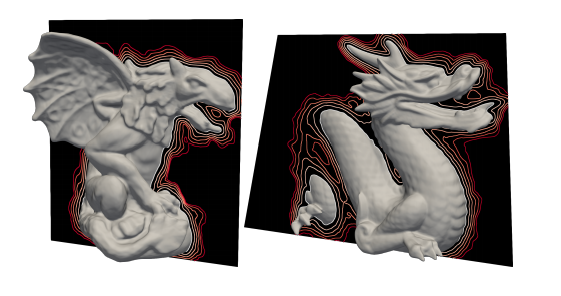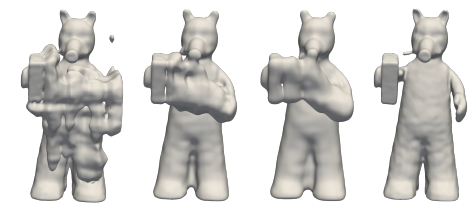This repository contains an unofficial implementation to the paper: "Phase transitions distance functions and implicit neural representations".
Representing surfaces as zero level sets of neural networks recently emerged as a powerful modeling paradigm, named Implicit Neural Representations (INRs), serving numerous downstream applications in geometric deep learning and 3D vision. Training INRs previously required choosing between occupancy and distance function representation and different losses with unknown limit behavior and/or bias. In this paper we draw inspiration from the theory of phase transitions of fluids and suggest a loss for training INRs that learns a density function that converges to a proper occupancy function, while its log transform converges to a distance function. Furthermore, we analyze the limit minimizer of this loss showing it satisfies the reconstruction constraints and has minimal surface perimeter, a desirable inductive bias for surface reconstruction. Training INRs with this new loss leads to state-of-the-art reconstructions on a standard benchmark.
For more details:
paper: https://arxiv.org/pdf/2106.07689.pdf
The code is compatible with python 3.7 and pytorch 1.2. In addition, the following packages are required:
numpy, pyhocon, plotly, scikit-image, trimesh.
IGR can be used to reconstruct a single surface given a point cloud with or without normal data and with or without adding fourier layer to the network. Adjust reconstruction/setup.json to the path of the input 2D/3D point cloud:
train
{
...
d_in=D
...
input_path = your_path
...
}
network
{
...
with_normals = True/False
with_fourier_layer = True/False
fourier_scale = scale parameter for fourier layer
}
Where D=3 in case we use 3D data or 2 if we use 2D. We support xyz,npy,npz,ply files.
Then, run training:
cd ./code
python reconstruction/run.py
Finally, to produce the meshed surface, run:
cd ./code
python reconstruction/run.py --eval --checkpoint CHECKPOINT
where CHECKPOINT is the epoch you wish to evaluate of 'latest' if you wish to take the most recent epoch.
The raw scans can be downloaded from http://dfaust.is.tue.mpg.de/downloads. In order to sample point clouds with normals use:
cd ./code
python preprocess/dfaust.py --src-path SRC_PATH --out-path OUT_PATH
where SRC_PATH is the absoule path of the directory with the original D-Faust scans, and OUT_PATH is the absolute path of the directory on which you wish to output the processed point clouds.
It is also possible to process only train data with input --mode 0 our only test with --mode 1.
In case you wish to only process part of the data (e.g. for parallel processing) it is possible by adding --names NAME_1,NAME_2,...,NAME_k where NAME_i is one of D-Faust shapes e.g. 50002, 50020.
After preprocessing ended adjust the file ./shapespace/dfaust_setup.conf to the cur path of the data:
train
{
...
dataset_path = OUT_PATH/dfaust_processed
...
}
We have uploaded IGR trained network. To produce predictions on unseen test scans, run:
cd ./code
python shapespace/eval.py --checkpoint 1200 --exp-name dfaust_pretrained --split dfaust/test_all.json --exps-dir trained_models
In case you wish to generate less models you can use --split dfaust/test_models.json
To meshs of latent interpolation between two shapes use:
cd ./code
python shapespace/interpolate.py --interval INTERVAL --checkpoint 1200 --exp-name dfaust_pretrained --exps-dir trained_models
Where INTERVAL is the number (int) linspace of latent interpolations.
In case you wish to interpolate different shapes adjust the file dfaust/interpolation.json
If you want to train IGR yourself, run:
cd ./code
python shapespace/train.py
If you find our work useful in your research, please consider citing:
@misc{lipman2021phase,
title={Phase Transitions, Distance Functions, and Implicit Neural Representations},
author={Yaron Lipman},
year={2021},
eprint={2106.07689},
archivePrefix={arXiv},
primaryClass={cs.LG}
}


